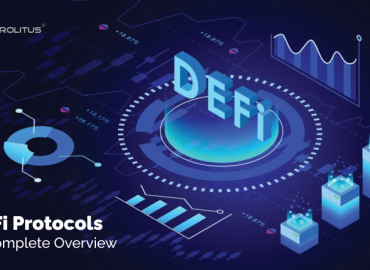The centralized financial (CeFi) system often kept people in the dark about the rules or agreements. Not everyone has access to regulations that govern financial assets and goods, which often appear mysterious to non-experts.
Contrary, decentralized finance (DeFi) is establishing its mark by providing a decentralized and transparent ecosystem to everyone. It harnesses the characteristics of blockchain technology that help to protect its integrity. However, numerous differences help to differentiate between CeFi and DeFi.
The article below details the crucial differences between CeFi and DeFi from a legal, security, economic, privacy, and market manipulation standpoint.
What is Centralized Finance (CeFi)?
The invention of centralized finance dates back to several thousand years ago in ancient Mesopotamia, where humans used a variety of goods and assets as currency. It was the standard for trading cryptos before DeFi was introduced. Centralized finance (CeFi) handles all crypto trade orders through a central exchange.
The platform or the central exchange manages all the funds, i.e., you don’t own a private key that provides access to your wallet. It exposes users’ funds to threats if the exchange’s security procedures fail. Also, an exchange decides the coins they wish to list for people to buy or the fees they want to charge for trading.
For example, exchanges such as Binance or Coinbase enable users to create accounts to utilize the platform for sending or receiving tokens. In addition to that, exchanges also offer several other services, such as borrowing, lending, and margin trading.
Hence, in centralized finance, you are not the owner of assets or cryptocurrencies when you proceed to buy or sell via a centralized exchange. You have to follow the rules and guidelines set by the centralized exchange to utilize its services.
What is Decentralized Finance? (DeFi)
As the name suggests, decentralized finance is made possible with the help of blockchain without the involvement of any central authority. It has made way for cryptocurrencies and enabled the transfer and trade of financial assets without trusted intermediaries.
DeFi works with the help of smart contracts – pieces of code that execute upon meeting certain conditions. DeFi helps to instil a sense of a fair and transparent financial system for everyone. It doesn’t distinguish anyone and allows anyone to participate and access financial and banking services.
Decentralized finance is compatible with most of CeFi’s products, ranging from loans to leveraged trading and decentralized governance to options and derivatives. It has three distinguishing characteristics: transparency, control, and accessibility. Unlike CeFi, the power of funds is in the hands of the people in DeFi. A person needs a smartphone or computer, an internet connection, and a little know-how to design and deploy DeFi goods.
One of the key benefits of using DeFi over CeFi is that you have complete control over your assets and own the key pair for your wallet. It allows users to utilize decentralized applications (dApps) built on the blockchain platforms to access DeFi services.
What is the difference between DeFi and CeFi?
Although you can find several differences between the two, it is essential to analyze whether users would trust technology or people. In DeFi, users trust the technology for all the services, while users trust a business in CeFi to manage funds. Let’s discuss some of the features of both ecosystems that differentiate them from each other.
Public verifiability
DeFi is transparent as most of the application code is available on the Internet. If not, its execution and bytecode must be publicly verifiable on a blockchain. Unlike CeFi, users of DeFi can verify the execution of DeFi state changes, providing transparency and an unrivalled power to transmit trust.
Atomicity
It is the state of a transaction to be either complete with all of its activities or fail collectively. Although atomicity is not present in centralized finance, platforms will use expensive and slow legal agreements to enforce it in the future.
Fiat Conversion
CeFi wins over DeFi as it provides more flexibility for converting fiat to cryptocurrency and vice versa. This is because conversion between fiat and crypto usually requires a centralized entity, which DeFi does not offer. Also, customers experience a better onboarding and customer experience in the Centralized Finance (CeFi) ecosystem.
Anonymous Deployment
Do you know Bitcoin’s founder has remained unknown to this day?
All of this is possible because anonymous teams manage many DeFi projects. Unlike CeFi, where users have less anonymity, DeFi allows DApps to function without a front-end, forcing users to engage directly with the smart contract.
Trustless
Users using the DeFi services don’t need to trust that the service will perform as promoted. They can verify that DeFi services perform as intended by auditing their code and using external tools such as Etherscan to identify if the platform correctly executed a transaction.
Privacy
You can only find decentralized finance on blockchains with non-privacy-preserving smart contracts. Hence, they provide pseudo-anonymity rather than true anonymity. In centralized exchanges, the power resides with them to reveal address ownership to law enforcement.
Transaction costs
To avoid spam transactions, it is essential to make transaction fees in decentralized finance. Contrary to this, CeFi platforms can offer transaction services at no cost because of the capacity to rely on anti-money laundering (AML) verification of their clients.
Custody
Unlike CeFi, DeFi users have complete control over their assets. However, with power comes great responsibility for users. In the event of a technological hazard, users have to bear the consequences. Hence, centralized exchanges are famous for keeping cryptocurrency assets.
DeFi versus CeFi
| Decentralized Finance | Centralized Finance |
| In DeFi, the user has complete control over their funds. | In CeFi, the power of funds remains with the exchange. |
| DeFi provides services such as borrowing, lending, payments, and trading. | CeFi provides services such as borrowing, trading, fiat-to-crypto, payments, and lending. |
| In case of any mishappening, the exchange is not accountable for funds. | Users are at the mercy of the exchange. They can choose to repay or not in case of any vulnerability on the exchange. |
| The market cap of DeFi is a little over $50 billion. | The market cap of CeFi is over $350 billion. |
| The security of decentralized exchanges depends on the technology you are using. | In most cases, centralized exchanges are responsible for security. |
| The concept of customer support doesn’t exist in DeFi. | Most of the centralized exchanges provide customer support to users. |
Final Thoughts
Decentralized and Centralized Finance have pros and cons. They aim to achieve the same goal. It solely depends on the user and what they need from the platform. DeFi is a suitable model to choose from if you prefer transparency and privacy. In contrast, if your priority is trust, sharing of risks, flexibility, and increased options to invest, you should opt for CeFi.
Prolitus has an expert, professional team of blockchain developers who can help you solve all your blockchain needs. Our blockchain consultants can help you identify a suitable financial model for your business. Get in touch with our team to start blockchain development.
Frequently Asked Questions (FAQs)
Q1. What is a CeFi?
Ans. CeFi, short for centralized finance, looks to incorporate certain features of the traditional financial system into the decentralized finance ecosystem.
Q2. What is the difference between Bitcoin and DeFi?
Ans. Bitcoin is similar to a fiat currency that operates on its own blockchain. It is used as a store of value. In contrast, decentralized finance (DeFi) allows you to lend, borrow, and trade cryptocurrencies like Bitcoin, akin to quintessential financial institutions like banks.
Q3. Is Binance DeFi or CeFi?
Ans. Binance is the world’s leading cryptocurrency exchange by trading volumes. It has launched a new iteration of its blockchain interoperability service (Bridge 2.0) that allows users to access both decentralized (DeFi) and centralized (CeFi) finance systems directly from the platform’s app.





